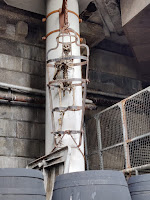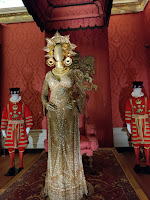 Full disclosure – I didn’t see the Buckingham palace, didn’t
go up the London eye or take a cruise down the Thames, on my 10-day trip to the
UK.
Full disclosure – I didn’t see the Buckingham palace, didn’t
go up the London eye or take a cruise down the Thames, on my 10-day trip to the
UK.
Why? So, here’s the best thing about being a solo traveller –
you get to do just exactly what you want to do – your time, your interests,
your schedules.
I guess the big difference is whether you’re a traveller or
a tourist or on a holiday. I don’t consider any of my trips to be holidays;
they are experiences. When you travel, it's more about the journey than the
destination. You don’t follow the 10 best things to see or do in a place – I mean
sure, you do some of them, but its perfectly fine to not do them if
 When you go off the beaten path, you discover nuggets and treasures that one would never find in any travel guide or could
have planned in advance.
When you go off the beaten path, you discover nuggets and treasures that one would never find in any travel guide or could
have planned in advance.  Being a woman solo traveller, there is an aspect of safety
to be considered. Fingers crossed, I have not come across any negative experiences thus far, even when I have ventured completely off-beat and off season. That
both emboldens me to explore more but also makes me cautious to ensure that I continue
to stay safe. One is more aware and instinctive when travelling alone. I have
actually found people to be more friendly and helpful when they know you
are travelling alone, contrary to popular belief. One needs to practice this
strange dichotomy of being open and trusting while at the same time being
cautious (but not wary) of people, places and experiences. Successfully navigating a totally unknown
place can be hugely liberating, a confidence booster, and more importantly an
immense learning experience.
Being a woman solo traveller, there is an aspect of safety
to be considered. Fingers crossed, I have not come across any negative experiences thus far, even when I have ventured completely off-beat and off season. That
both emboldens me to explore more but also makes me cautious to ensure that I continue
to stay safe. One is more aware and instinctive when travelling alone. I have
actually found people to be more friendly and helpful when they know you
are travelling alone, contrary to popular belief. One needs to practice this
strange dichotomy of being open and trusting while at the same time being
cautious (but not wary) of people, places and experiences. Successfully navigating a totally unknown
place can be hugely liberating, a confidence booster, and more importantly an
immense learning experience.
 Soloing often has a perception of just picking up a backpack
and just going somewhere. It actually involves a lot of planning (most of it
well before you actually embark on one). I prefer to do all my bookings –
travel, stay etc. by myself; that is, I don’t use any travel consultants or
agents. This again gives one the
flexibility to pick what suits you, but also has an element of not following the
tried and tested. Be open for some amazing experiences, or not so very - it could go either ways. I usually do my own travel bookings – to and fro
and the stay – what I do once I get there is usually open. I prefer to avoid large hotel chains for stay – again, this can be a trade off between getting
something professional and efficient (but cold and standard) and the charm of
something homely and authentic. For me
this is part of the whole experience and I have found some gems – Chonor house
in McLeod Ganj is actually a guest house that is run by the main temple (next to
Dalai Lama’s residence). It has just 6/7 rooms, but each room is a store house
of art – every room is luxuriously fitted and has a theme. The food is simple
and basic but cooked with care and love by people working with the temple. Deewanji
Ni Haveli is a 300-year-old meticulously restored heritage home in old
Ahmedabad, complete with a stepwell inside the house. No intercoms to order your morning coffee –
one just opens a jharoka overlooking the courtyard below and calls out for it😊. I must confess, I was initially
a bit wary, as it is situated amidst a narrow gully in a crowded marketplace, and
the walls and doors so thick that one cannot hear any noise from outside and vice
versa. I was travelling off season and
was the only guest in that place. Scary, but I was treated like a royalty in my
own haveli. Had a similar experience at Bhuj House, yet another 2/300-year-old Parsi
manor. Again, being the only guest, even Imli the kitten treated me like her
own and would come into my room to give me company. The staff would ask me what
I wanted for breakfast or dinner and prepare to my liking.
Soloing often has a perception of just picking up a backpack
and just going somewhere. It actually involves a lot of planning (most of it
well before you actually embark on one). I prefer to do all my bookings –
travel, stay etc. by myself; that is, I don’t use any travel consultants or
agents. This again gives one the
flexibility to pick what suits you, but also has an element of not following the
tried and tested. Be open for some amazing experiences, or not so very - it could go either ways. I usually do my own travel bookings – to and fro
and the stay – what I do once I get there is usually open. I prefer to avoid large hotel chains for stay – again, this can be a trade off between getting
something professional and efficient (but cold and standard) and the charm of
something homely and authentic. For me
this is part of the whole experience and I have found some gems – Chonor house
in McLeod Ganj is actually a guest house that is run by the main temple (next to
Dalai Lama’s residence). It has just 6/7 rooms, but each room is a store house
of art – every room is luxuriously fitted and has a theme. The food is simple
and basic but cooked with care and love by people working with the temple. Deewanji
Ni Haveli is a 300-year-old meticulously restored heritage home in old
Ahmedabad, complete with a stepwell inside the house. No intercoms to order your morning coffee –
one just opens a jharoka overlooking the courtyard below and calls out for it😊. I must confess, I was initially
a bit wary, as it is situated amidst a narrow gully in a crowded marketplace, and
the walls and doors so thick that one cannot hear any noise from outside and vice
versa. I was travelling off season and
was the only guest in that place. Scary, but I was treated like a royalty in my
own haveli. Had a similar experience at Bhuj House, yet another 2/300-year-old Parsi
manor. Again, being the only guest, even Imli the kitten treated me like her
own and would come into my room to give me company. The staff would ask me what
I wanted for breakfast or dinner and prepare to my liking.
Alone or lonely – do I
miss company? Often, it’s after a long
day and back in the room, and most places I stay in do does not have a TV. Or going
into a restaurant to eat alone. Or sometimes,
yes, it would be great to share an experience with someone. There are trade-offs, but well, so does
life. And I have chosen the road less
travelled, and more often than not, it has been extremely rewarding. Try it once, is my advice…you never know if
you enjoy it unless you do.
















































